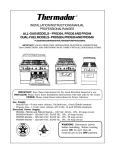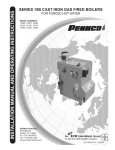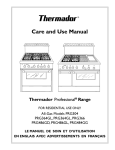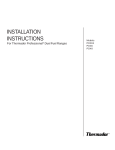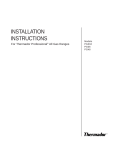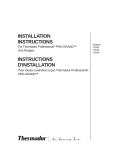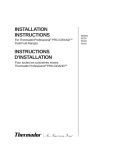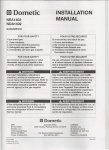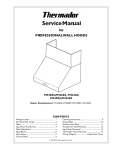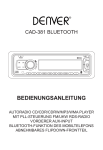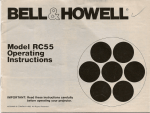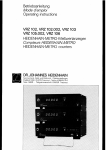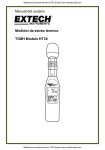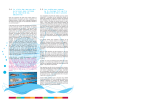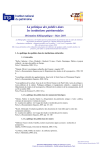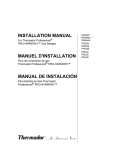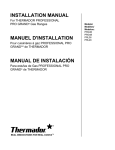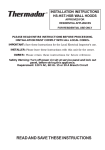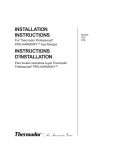Download Thermador Range PRDS48 User's Manual
Transcript
Th dor ® CORPORATION 6D 00 INSTALLATION INSTRUCTIONS MANUAL PROFESSIONAL RANGES ALL-GAS MODELS - PRG304, PRG36 ANqTPRG48. DUAL-FUEL MODELS - PRDS304, PRDS36 AND~PRDS48 PLEASE READ ENTIRE INSTRUCTIONS BEFORE PROCEEDING. IMPORTANT: LOCAL CODES VARY. INSTALLATION, ELECTRICAL CONNECTIONS, GAS CONNECTIONS. AND GROUNDING MUST COMPLY WITH ALL APPLICABLE CODES. ill) —11 IMPORTANT: Save these instructions for the Local Electrical Inspector's use. INSTALLER: Please leave these Installation Instructions with this unit for the owner. OWNER: Please retain these instructions for future reference. Gas Supply: Natural Gas - 6 inch water column. (14.9mb) min., 8 inch (20mb) nominal Propane Gas - 11 inch water column. (27.4 mb), 14 inch (37mb) maximum Electrical Power Supply: PRG304, PRG36 and PRG48 Models - 120 VAC, 60 Hz.. lPh., 20 Amp circuit. PRDS304 Model - 120/240 VAC, 50/60 HZ., lPh., 20 Amp circuit. PRDS36 Models - 120/240 VAC, 50/60 Hz., lPh., 35 Amp circuit. PRDS48 Models - 120/240 VAC, 50/60 Hz., lPh., 50 Amp circuit. WARNING: Disconnect power before installing. Before turning power ON, be sure that all controls are in the OFF position. IMPORTANT INSTALLATION INFORMATION Model PRDS484GG INTRODUCTION (Shown with Low Back Guard Model PRS48LB) WARNING: Improper The Thermador Professional* Ranges are free standing units installation, adjustment, alteration, service or main available in a number of configura tenance can cause injury or tions. Model PRG304 is equipped with four sealed gas surface burn ers, a large capacity gas oven with property damage. Refer to this manual. For assistance or additional information gas infra-red broiler and convection consult a qualified installer, service agency, manufac turer (dealer) or the gas supplier. \ system. Models PRG364GD. PRG364GL, and PRG366 feature a gas cooking surface with four sealed burners and a griddle, four sealed / burners and a grill, or six sealed — Do not store or use burners, in addition to a large capacity gas oven with gas infra-red gasoline or other broiler. Models PRG484GG, PRG486GD, and PRG486GL feature flammable vapors and liquids in the vinicity of this or any other appliance. a gas cooking surface with four sealed burners, griddle and grill, six sealed burners and a griddle, or six sealed.burners and a grill. WHAT TO DO IF YOU SMELL GAS • • Do not try to light any appliance. Do not touch any electrical switch; do not and a small gas oven with broil capability. ■ Model PRDS304 is equipped with 4 four sealed gas surface burners and oven with broil capability. Models Immediately call your PRDS364GD. PRDS364GL. and gas supplier from a 1 PRDS366 offer the same cooking surface configurations but are neighbor's phone. Fol low the gas supplier's i equipped with a professional size, instruction. electric convection, self-cleaning If you cannot reach your gas supplier, call the oven with broil capability. Models PRDS484GG. PRDS486GD. and PRDS486GL feature a gas cooking fire department. — Installation and service surface with fo'jr sealed burners, Model PRDS364GD griddle and grill, six sealed burners must be performed by a and a griddle, or six sealed burners qualified installer, (Shown with High Shelf Model PRS36HSI and a grill. PRDS48 Ranges provide service agency or the a large electric oven (toe same as gas supplier. > Model PRG366 (Shown with Island Trim Model PRS36ITI an electric convection, self-cleaning building. • PRG48 Ranges provide a large gas oven (the same as used in the PRG36 Ranges) use any phone in your • 23 used in the PRDS36 Ranges) and a ' TA"RT V OF rONTFMT^ small electric oven with a bread proofing feature and broil capability. Warning 1-2 Introduction 3 Important Installation Information 3 Step 1: Ventilation Requirements 3 Step 2: Cabinet Preparation 4 Step 3: Unpacking, Moving And Placing The Range 8 Step 4: Install Anti-Tip Device 10 Step 5: Gas Requirements & Hookup 15 Step 6: Electrical Requirements, Connection & Grounding 16 Step 7: Backguard Installation 20 Step 8: Test And Adjustment 21 Installer Checklist 23 52: V AVERTISSEMENTS EN FRANCAIS Thermadar CORPORATION For Residential Use Only ® ALL-GAS MODELS - PRG304 AND PRG36, DUAL FUEL MODELS PRDS304, PRDS36 AND PRDS48 CET MAN U EL CONTEN IT AVERTISSEMENTS EN FRANCAIS AVERTISSEMENT: Couper le courant avant d'installer. Avant de mettre EN MARCHE, soyez certain que tous les controles sont dans la position ARRETE. AVERTISSEMENT: DANGER DE RENVERSEMENT DE LA CUISINIERE ^AVERTISSEMENT: L'lnstallatlon inexacte. rajustement. la modification, le service ou l'entretien peut causei la blessure ou la propriete endommagee. Serefererace manuel. Pour l'assistance ou (1) En branchant l'apparell au gaz de propane, soyez certain que le reservoir de gaz du propane est equipe avec son regulateur de haute presslon en addition du regulateur de celui-ci ou sucum autre pression fourni avec cet appareil. La pression de gaz maximale a cet appareil ne doit pas exceder une colonne d'eau de 14.0 pouces du regulateur du reservoir de gaz du propane. (2) Cet appareil est dessine comme un appareil de cuisson. Base sur les considerations de securite, ne le jamais utiliser pour le chauffage ou de falre appareil. chauffer une chambre. rinformation addltionnelle consulter un installateur qualifle. une agence de service, le fabrlcant (le marchand) ou le fournisseur de gaz. • ATTENTION: Ne pas emmagasuner ou utiliser de l'essence ou des autres vapeurs inflammables et liquides aux endr oits de CE QUI FAIRE SI VOUS SBNTEZ LE GAZ. • Ne pas essayer d'allumer aucun appareil. • Ne pas toucher aucun Ne pas installer les cuisinieres du Modele PRDS48 tel que la porte du pas utiliser aucun telephone four est au ras du devant du cabinet. Une installation a dans votre batiment. ras peut resulter au interrupteur electrique; ne • ATTENTION: Appeler immediatement votre four nisseur de gaz du telephone dun voisin. Suivre dommage des cabinets par suite de l'explosition a la haute chaleur. l'instruction du four nisseur de gaz. • ATTENTION: Instructions. • Si la cuisinifere est tirfee loin du mur pour le nettcyage, l'entretien, ou toute autre raison, assurer que Les Appareils Anti-Renverses ont rengages correctement quand la cuisiniere est poussfce contre le mur. Dans revene-ment d'usage abnormale (tel qu'une personne qui est debout, est assise, ou est inclinee sur une porte ouverte), l'echec de prendre cette precaution peut avoir pour le resultat le renverse-ment de la cuisiniere. La blessure elle-meme. main d'oeuvre adequate installateur qualife, une pour eviter le degat et/ ou la blessure personnelle. L'appareil est lourd et doit agence de service ou le 6tre manie in consequence. doivent etre executes par un l'appareil n'est pas installe conformement aux ces le mouvement de rappareil contracter votre four nisseur, • L'installation et le service ment peut exister si doivent etre utilises dans Le materiel adequat et la incendies. • Un risque de renverse- personnelle peut resulter des liquides chauds repandus ou de la cuisiniere Si vous ne pouvez pas telephoner le service des • Toutes le cuisinieres peuvent renverser et la blessure peut resulter. Pour empeche le renversement accidentel de la cuisiniere, l'attacher au mur, au plancher, ou a ramoire en installant L'Appareil Anti-Renvers6 fourni. fournisseur de gaz. Page 1 AVERTISSEMENTS EN FRANCAIS ADVEHnBfflJVIENlY s • TOUTESLESCUISINIERES PEUVENTRENVERSER • LESBLESSURESAUX PERSONNES PEUVENT R&ULTER • INSTALLER L'APPAREIL ANTl-RENVERSER EMALLE AVEC LA CUISINIERE • VOIR LES INSTRUCTIONS ^INSTALLATION LES DEGATS DE LA PROTRIETE • Contacter un installateur ou un entrepreneur du batiment quallfie pour determiner la methode convenable pour forer les trous a traverse du materiau du mur du plancher (tel que ie carreau ceramique, le bols feuillu, et c.) • Ne pas glisser la culslnlere en traverse d'un plancher qul n'est pas protege. • U echec des sulvre oss instructions peut resuter au degats aux revStements d" mur ou du plancher AVERTISSEMENT: ATTENTION: En branchant l'appareil au gaz de propane soyez certain que le reservoir de gaz du propane est £quip£ avec son rggulateur de haute pression a lui-meme en addition du regulateur de pression fourni avec l'appare La pression du gaz fourni avec l'appareil. I pression du gaz fourni au regulateur de l'appareil ne doit pas excSder une colonne d'eau de 14". >v <► ATTENTION: RISQUES D* ELECTROCUTION Fair preuvre d extreme prudence au cas ou il serait necessaire de percer le mur ou Ie plancher. Desfils electriques peuvent etre dlssimules darriere le mur ou sous le plancher. Identifier les circuits electriques qul pourraient etre endommages par 1'instaUatlon du dispositif anti-bascule, et couper le courant de ces circuits. L1 echec des suivre ces instructions peut resuter au danger delectrocution et de blessures. ATTENTION: Uapparlel doit etre isole du systeme de tuyauterie de la fourniture de gaz en fermant la soupape a main d'arret individuel pendant l'essai du systeme de tuyauterie de la fournlture de gaz aux pressions. d'epreuve egale a ou au moins que 1/2 pslg (3.5 kPa.). L'appareil et sa soupape d'arrfit Individuel doivent etre deconnectes du systSme de tuyauterie de la fourniture de gaz pendant l'essai du systeme aux pressions d'epreuve en plus de 1/2 psig (3.5 kPa). En examlnant la pression de gaz du collecteur, la pression d'entrde au regulateur doit etre au moins de 6.0" W.C. pour le gaz naturel ou 11.0" pour le propane. Ne pas tenter aucun reglage du regulateur de pression. ATTENTION: Themador recommande que les ajustements du bee soient faits par un technicien quallfie au temps de rinstallation. Un soin extreme doit etre pris quand les ajustements sont faits apres l'lnstallation. Les ajustements inexacts ou la manque des ajustements peut annuler votre garantie. Page 2 IMPORTANT INSTALLATION INFORMATION /^IMPORTANT: ity of this unit, particular attention should be paid to the hood and duct work installation to assure it meets local building codes. To eliminate risk of burns or fire caused by reaching over heated surface units, cabinet storage located above the surface units should be avoided. All ranges must be installed with a backguard. Models PRG304 and PRDS304 are shipped from the factory with a standard 9" backguard. For all other models one of three available backguards must be ordered separately and installed at the back of the range. The three backguard choices include a Low Back Guard, High Shelf, or Island Check local building codes for the proper method of appliance installa VTrim. See STEPS 2 and 6. tion. Local codes vary. Installation, This appliance has been tested in accordance with ANSI Z21.1 Current Issue, Standard for Household Cooking Appliances (USA) and in must comply with all applicable codes. In the absence of local codes the electrical connections and grounding appliance should be installed in Domestic Gas Ranges (CANADIAN). accordance with the National Fuel Gas Code ANSI Z223.1 Current Issue and National Electrical Code ANSI/NFPA It is strongly recommended that this 70-Current Issue. In Canada, installa accordance with CAN 1.1-M81 tion must be in accordance with the appliance be installed in conjunction CAN 1-B 149.1 and .2 - Installation with a suitable overhead vent hood. ments.) Due to the high heat capabil- Codes for Gas Burning Appliances and/or local codes. It is strongly recommended that a hang the range cooking surface by 6" suitable exhaust hood be installed on both sides. (See Step 1 for Ventilation Require This appliance is equipped with an intermittent/interrupted ignition device that cycles the two far left surface burners on and off when in the ExtraLow® setting. <► CAUTION: (1) When connecting the unit to propane gas, make certain the propane gas tank is equipped with its own high pressure regulator in addition to the pressure regulator supplied with this unit. The maximum gas pressure to this appliance is not to exceed 14.0 inches (37mb) water column from the propane gas tank regulator. (2) This unit is designed as a cooking appliance. Based on safety considerations never use it Vjbr warming or heating a room. STEP1: VENTILATION REQUIREMENTS above the range. Downdraft ventilation CAUTION: Ventilation hoods and blowers are designed for use with should not be used. The table below indicates the Thermador hoods, by single wall ducting. However, some model number, that are recommended local building codes or inspectors for use with the 30", 36". and 48" may require double wall ducting. ranges. Consult local building codes and/or 1. Select Hood and Blower Models: local agencies, before starting, to • For wall installations, the hood width assure that hood and duct installa tion will meet local requirements. must, at a minimum, equal the width of the range cooking surface. Where space permits, a hood larger in width • Hood blower speeds should be variable to reduce noise and loss of than the cooking surface may be heated or air conditioned household desirable for improved ventilation air when maximum ventilation is not performance. required. Normally, the maximum blower speed is only required when • For island installations, the hood RANGE WIDTH WALL INSTALLATION HOOD* 30" RANGE 36" RANGE 48" RANGE Notes • For best smoke elimination, the lower edge of the hood should be installed a minimum of 30" to a maximum of 36" above the range cooking surface. (See Fig. 1). • If the hood contains any combus tible materials (i.e. a wood covering), it must be a minimum of 42" above the cooking surface. 3. Consider Make-Up Air: • Due to the high volume of ventila tion air, a source of outside replace ment air is recommended. This is particularly important for tightly sealed and insulated homes. • A qualified heating and ventilating contractor should be consulted. using the grill. width should, at a minimum, over- 2. Hood Placement: BLOWER' PH30HQS VTR1000Q. VTR1400Q PHE30.36 orVTNIOOOQ PH36HQS VTR1000Q. VTR1400Q PHE36.42 orVTNIOOOQ PH48HQS VTR1000Q. VTR1400Q PHE48.60 orVTNIOOOQ ISLAND INSTALLATION HOOD BLOWER PHI48QS VTR1400Q PHI48QS VTR1400Q PHI60QS VTR1400Q ' For wall installations where adequate space is available, the installer or user may elect to use a hood that is wider than the range cooking surface This may be particularly beneficial for those cases, such as a long duct run or heavy usage of the grill, in which improved capturing of the cooking exhaust is desired " Thermador offers a choice of remote (VTR1000Q or VTRHOOq) or in-hood (VTN1000Q) blowers for use in wall installations. Page 3 STEP 2: CABINET PREPARATION 1. The range is a free standing 4. unit. If the unit is to be placed adjacent to cabinets, the clearances shown in Fig. 1 are required. The same clearances apply to island installations, except for the overhead cabi nets, which must have a space 5. 6. wide enough to accept the flared island hood, as indicated The PRDS48 Ranges must be placed with the oven door projecting out from the cabinet face. The cabinet face should line up with the oven front frame, which is the surface that the oven door closes against. (See Fig. 2b and 2c illustrating side views of 48" ranges.) 3. required for each type of head cabinets installed on either side of the hood is 13". backguard. 7. Always keep appliance area clear and free from combustible Any openings in the wall behind the range and in the floor under the range must be sealed. materials, gasoline and other flammable vapors and liquids. 8. When there is less than a 12" horizontal clearance between Do not obstruct the flow of combustion and ventilation air to the unit. combustible material A and the back edge of the range above in Fig. 1. 2. The maximum depth of over The gas and electrical supply should be within the zones shown in Fig. 3a, 3b and 3c. FIG. 1 Cabinet Clearances CAUTION: the cooking surface, a Thermador Low Back or High Do not install the iModel PRDS48 ranges such that the Shelf backguard must be installed. (See Fig. 2a). When oven door is flush with the clearance to combustible cabinet face. A flush installa material A is over 12", a tion could result in damage to Thermador Island Trim may be the cabinets due to exposure used. (See Fig. 2b). Except in to high heat. the case of 30" Ranges, A backguards must be ordered As defined in the "Nationa\ Fue\ separately. Figures 2a. 2b Gas Code" (ANSI Z223.1. Latest and 2c indicate the space Edition). 30" Wide Hood (Model *PH30QS) 48" for Island (Model #PHI48QS) I For 30' Ranges 36" Wide Hood (Model #PH36QS) 48" for Island (Model #PHI48QS) j For 36" Rangej 48" Wide Hood (Model 0PH48QS) 60" for Island (Model #PHI60QS) | For 48' Ranges' Min. Distance Between Overheaad -4-»» alA Cabinets of Combustible Material A 30" Range - 30" 36" Range - 36" 48" Range - 48" 30" Min. to 36" Max. bottom of overhead 18" Min. Hood to cooking surface (42" if hood contains combustible I 13"M Cabinet CAUTION: See Depth Range width 30". 36" or 48" 12' Mn to combus tible side wan combustible "' cii .A materials A) (bom Figs. 2a 2b and 2 c 42' Min to material A. from cooking surface sees! For Electrical and Gas Supply Zone, "see Figures 3a, 3b and 3c. Zone size and position differ according to the model. •35-3/8" Min. Range Height with Leveling Legs fully retracted •36-3/4" Max. Range Height with Leveling Legs fully extended A as defined in the "National Fuel Gas Code" (ANSI Z223.7. Latest Edition). 'The range height is adjustable. The level of the range top must be at the same level or above the countertop level. Page 4 STEP 2: CABINET PREPARATION FIG. 2a FIG. 2b Side View 30" Ranges - Com bustible //// Side View 36" and 48" Ranges //// //// ///S //// -—Com- Materials & 28-3/4' 27-5/8" Optional High Shelf AY Mln. to Combustibles A 42" Mln. to Std. Combustibles A __ Low Back Guard (Provided with 30" Range) Clearance s/ss ss/s // 26-3/8' »► +— 24-3/8" *- 16-1/2"—> A as defined in the 'National Fuel Gas Code* (ANSI Z223.1. Current issue). FIG. 2c Side View 30", 36" and 48" Ranges CombuHtbte Materials A 12" Min. to Combustibles A CAUTION: without Backguard Combustibles A or with island Trim Do not install the Model PRDS304 and Island Trlrr PRDS48 ranges such that the front surface of the oven door is flush with the cabinet face. A flush installation could result in damage to the cabinets due to high heat. The face of the 1-1/2* cabinet should line up with the oven front frame. The front frame location relative to the rear of the range is 24-3/ 8" on the PRDS304 and 25" on the PRDS48, as shown in Figures 2a and 2b. Clearance '//// \ 777/ //// //// 30" Ranges - 26-3/8" 36" & 48" Ranges - 28" Page 5 STEP 2: CABINET PREPARATION GAS AND ELECTRIC SUPPLY ZONES: FIG. 3a Gas & Electrical Supply Zone for PRG304, PRG36 & PRG48 All-Gas Ranges 5/8" Flex Line to Typical placement shown. Other placement of Gas Appliance Three-Prong, with a power supply cord with a three-prong grounding plug. IT MUST BE PLUGGED 120 VAC Receptacle Supply and Electrical Receptacle within the Electrical and Gas Supply The All-Gas Ranges are factory equipped INTO A MATING, GROUNDING-TYPE. 120 VAC RECEPTACLE THAT IS CON1/2" N P T NECTED TO A CORRECTLY POLARIZED Gas & Electrical Supply Zone Zone is acceptable. AND GROUNDED 120 VAC CIRCUIT. (See STEP 6.) NOTE: A Manual Gas The range must beconnected only to the Shut-Off Valve (not shown) must be easily accessible If the range is to be connected to propane type of gas for which it is certified. gas, ensure that the propane gas supply through an adjacent tank is equipped with its own high pressure 1 3/4" Maximum cabinet without moving regulator in addition to the pressure Protrusion from Wall the range. regulator supplied with the range. (See for Gas Supply STEP 5.) FIG 3b Gas & Electrical Supply Zone for PRDS304 Dual-Fuel Ranges The Dual-Fuel ranges may be connected to the power supply with a 3-pole, 3conductor range supply cord kit, a 3-pole, Appliance 4-conductor range supply cord kit or by hard-wiring to the power supply. It is the 1/2" N.P.T. responsibility of the installer to provide the 240 VAC Receptacle proper wiring components (cord or conduit (Shown) or Junction and wires) and complete the electrical Box connection as dictated by local codes and Gas & ordinances, and/or the National Electric Electrical Code. The units must be properly •^Supply Zone grounded. Refer to Step 6 for details. Typical placement shown. 5/8" Flex Line to Other placement of Gas Supply and Electrical Receptacle within the Electrical and Gas Supply Zone is acceptable. NOTE: A Manual Gas Shut-Off Valve (not shown) must be easily The range must be connected only to the type of gas for which it is certified. If the accessible 2" Maximum Protru through an adjacent cabinet without sion from Wall for Gas Supply moving 4-3/4" the range. range is to be connected to propane gas, ensure that the propane gas supply tank is equipped with its own high pressure regulator in addition to the pressure regulator supplied with the range. (See STEP 5.) FIG. 3c Gas & Electrical Supply Zone for PRDS36 and PRDS 48 Dual-Fuel Ranges The Dual-Fuel ranges may be connected Typical placement shown. Other placement of Gas Supply and Electrical Receptacle 5/8" Flex Line to Appliance within the Electrical and Gas Supply Zone is acceptable. 240 VAC Receptacle (Shown) or Junction NOTE: Box A Manual Gas Shut-Off Valve (not shown) must be easily accessible through an adjacent cabinet without moving the range. PRDS36 7" PRDS48 12" Supply Zone and wires) and complete the electrical connection as dictated by local codes and ordinances, and/or the National Electric Code. The units must be properly grounded. Refer to Step 6 for details. The range must be connected only to the type of gas for which it is certified. If the 2" Maximum Protrusion from Wall for Gas Supply range is to be connected to propane gas, ensure that the propane gas supply tank is equipped with its own high pressure regulator in addition to the pressure regulator supplied with the range. (See STEP 5.) B Model Electrical to the power supply with a 3-pole, 3conductor range supply cord kit, a 3-pole. 4-conductor range supply cord kit or by hard-wiring to the power supply. It is the responsibility of the installer to provide the proper wiring components (cord or conduit 16" Page 6 STEP 2: CABINET PREPARATION I ELECTRICAL SUPPLY, DUAL FUEL RANGES Installation of Dual Fuel ranges This is especially critical if the must be planned so that the junction box in the wall will be rough-in of the junction box for directly behind the junction box on the unit when the unit is the receptacle or conduit connec tion will allow maximum clear ance to the rear of the unit. installed. Refer to Figures 16 and 16a for location of junction box on unit. Orient the recep tacle or conduit connector to When the power supply cord (not supplied) or conduit is connected to the mating receptacle or junction box cover, the combined plug/receptacle or junction box cover/conduit connector should protrude no more than 2-1/4 minimize binding when the unit is connected to the receptacle or junction box and slid back in position. inches from the rear wall. See Figure 3d. FIG. 3d Wall Connection 2-1/4" Max n 2-1/4" Max. When Plugged in Junction Box & Conduit Power Cord & Receptacle Page 7 STEP 3: UNPACKING, MOVING AND PLACING THE RANGE <► CAUTION: Proper equipment and adequate manpower must be used in moving the range Chart A 30" Range 36" Range 48" Range Shipping Weight 335 lbs. 444 lbs. 584 lbs. Weight without 285 lbs. 390 lbs. 524 lbs. 215 lbs. 295 lbs. 395 lbs. to avoid damage to the unit packing materials or the floor. The unit is heavy and rests on adjust able steel legs. After removing door(s), burner caps, front kick • The range has an approximate 30" Range Chart B shipping weight as shown in Chart A. It is recommended that the door(s), grates, burner caps, front kick panel and oven racks be removed to facilitate handling. This will reduce the weight as shown in Chart A and allow the J V panel and oven racks Doorway Width Required 28-7/8" 36" Range 48" Range 30-7/8" 30-7/8" 29-1/2" 29-1/2" (Unit Assembled) Doorway Width Required 27-3/4" . (Oven Door(s) Removed) range to pass through 30" door ways. See Chart B and Fig. 2a and 2b. Do not remove the grill or griddle assemblies. FIG. 4 All Ranges - Removal of Kick Panel and Two Front Shipping Bolts FIG. 5 All-Gas and Dual Fuel Ranges -Removal of Two Rear Shipping Bolts • Remove the outer carton and packing material from the ship ping base. Remove the front kick panel (see Fig. 4) by removing two (2) screws at the top and pulling forward. The dual fuel ranges are held to the skid by four (4) bolts, the front two (2) are behind the kick panel (see Fig. 4) and the rear two (2) are located on the bottom flange of the range back Kick (see Fig. 5). All-gas ranges are Panel held in place by 4 bolts, two (2) as shown in Fig. 4 and two (2) at FIG. 6 the rear as shown in Fig. 5. After All Ranges Door Removal removing the bolts the range must be lifted and removed from Hinge Latch the skid. • To remove the door, open the door to the fully open position. Close the hinge latches (See Fig. 6) by rotating towards the door top. The door can then be re moved by gently lifting and pulling the door, with the hinges Hinge Clip In Locked Position up and out of the frame. Do not lift the range by the door handle(s). Page 8 Lower Clip After Replacing Door STEP 3: UNPACKING, MOVING AND PLACING THE RANGE Due to the weight, a dolly with soft wheels should be used to move this unit. The weight must be supported uniformly across the bottom (See Dolly Positioning Range Must be Fig. 7). Uniformly Supported by Braces Provided on Bottom yof Range After transporting the professional range by dolly close to its final location, the range can be tipped back and supported on the rear legs while the dolly is carefully removed. THE FLOOR UNDER THE LEGS SHOULD BE PRO TECTED (WOOD STRIPS, CAR PET, PANELING, ETC.) BEFORE PUSHING THE UNIT INTO POSI TION. The anti-tip device (30" and 36" ranges) must be installed (STEP 4). gas and electric connections should be made (STEPS 5 and 6). and the backguard installed (STEP 7) before the range is placed in its final position. For proper performance the profes sional range must be level. The range is leveled by adjusting the legs with a wrench. Replace the kick panel and oven doors by reversing the procedure described above. It is important that the two (2) screws retaining the kick panel are secure to prevent accidental access to live electri Griddle Level Adjustments The griddle should be level or tilted slightly forward and should not rock. Screws are installed in the back ledge to eliminate rocking and to adjust the level of the griddle. To access these screws (A) (see Fig. 8), carefully remove the black aluminum trim strips running front to back alongside the griddle, then lift the back of the griddle. cal components and wires. FIG. 8 Griddle Leveling Screws griddle leveling screw Page 9 ■ STEP 4: INSTALLING ANTI-TIP DEVICE For all 30" and 36" ranges, an anti-tip device must be installed as per these instructions. WARNING RANGE TIPPING HAZARD • ALL RANGES CAN TIP All ranges can tip and injury could result. To prevent accidental tipping of the range, attach it to the wall, floor or INJURY TO PERSONS COULD RESULT cabinet by installing the Anti-Tip Device INSTALL ANTI-TIP supplied. • A risk of tip-over may exist if the appli ance is not installed in accordance with these instructions. • If the range is pulled away from the wall DEVICES PACKED WITH RANGE SEE INSTRALLATION INSTRUCTIONS for cleaning, service, or any other rea son, ensure that the Anti-Tip Device is properly reengaged when the range is pushed back against the wall. In the event of abnormal usage (such as a person standing, sitting, or leaning on an open door), failure to take this precau tion could result in tipping of the range. Personal injury might result from spilled hot liquids or from the range itself. CAUTION PROPERTY DAMAGE Contact a qualified installer or contrac tor to determine the proper method for • WARNING drilling holes through the wall or floor ELECTRICAL SHOCK HAZARD etc.) Use extreme caution when drilling holes Do not slide the range across an unpro into the wall or floor. There may be tected floor. concealed electrical wires located behind Failure to follow these instructions may material (such as ceramic tile, hardwood, the wall or under the floor. • result damage to wall or floor coverings. Identify the electrical circuits that could be effected by the installation of the Anti-Tip Device, then turn off power to these circuits. • Failure to follow these instructions may result in electrical shock or other per sonal injury. Tools Needed for Installation of Anti-Tip Device: - Screwdriver, Phillips - Hammer - Drill, electric or hand - Pencil or other marker - Measuring tape or ruler - Wrench, 7/16" (PRG Ranges only) - 1/8" drill bit (wood or metal wall or floor) - Wrench adjustable (PRG Ranges only) - 3/16" carbide-tipped masonry drill bit (concrete or concrete block wall or floor) - 3/16" anchors, drywall or concrete, 2 each (not required if mounting bracket is being attached to solid wood or metal) Page 10 STEP 4: INSTALLING ANTI-TIP DEVICE Parts Required for Installation of Anti- Tip Device: PRG304 and PRG36 All Gas Ranges (Figures 9 and 10) Thermador Part No. Qty Description 15-10-916 4 Screw. Phillips,#10 x 1-1/2' 15-10-771 1 Anti-Tip Channel, Adjust FIG. 10 Adjustable Anti-Tip Channel PRG304 and PRG36 All-Gas Ranges able. PRG 15-10-772 1 Mounting Bracket. PRG 15-10-909 1 Bolt. Hex Head. l/4"-20x ■5-1/2" 15-10-910 1 Nut. Hex. 1/4-20 15-10-911 2 Washer. Flat. 1/4-20 15-10-948 2 Screw, Phillips. #10 x 1/2" FIG. 9 This Hole This Hole For Flush 1/2" For Flush Mount of PRG36 Mount of PRG 304 1-17/32" 1-9/32" Mounting Kit for PRG304 and PRG36 FIG. 11 All-Gas Ranges Mounting Kit for PRDS304 and PRDS36 Dual Fuel Ranges Mounting Bracket 15-10-772(1 Each) 15-10-909(1 Each) 15-10-770(1 Each) 15-10-916 (4 Each) 15-10-916 (4 Each) 15-10-771 (1 Each) 15-10-911 (2 Each) Prepare holes at fastener locations as identified below: 15-10-910(1 Each) 15-10-948 (2 Each) For walls, wall studs, or floors composed of solid wood or metal, drill 1/8" pilot PRDS304 and PRDS36 Dual holes. Fuel Ranges (Figure 11) Thermador Part No. 15-10-916 15-10-770 For walls or floors composed of drywall, sheet-rock or other soft materials, drill 3/ Qty Description 4 Screw. Phillips,#10x 1-1/2" 16" holes to a minimum depth of 1-3/4", Anti-Tip Channel, Adjustable, then tap plastic anchors into each of the 1 IMPORTANT INSTALLATION INFORMATION: • thickness of 3/4". The thickness of the wall or floor may a hammer. The anti-tip bracket may be attached to a solid wood cabinet having a minimum wall • • require use of longer screws, available at For walls or floors having ceramic tile your local hardware store. covering, drill 3/16" holes through the tile only, then drill into the material behind In all cases, at least two (2) of the bracket the tile as indicated immediately above. mounting screws must be fastened to solid If the range is moved to a new location, the Anti-Tip Device must be removed and rein wood or metal. • holes using a hammer. For walls or floors composed of concrete or concrete block, drill 3/16" holes to a minimum depth of 1-3/4", then tap con crete anchors into each of the holes using Use appropriate anchors when fastening the stalled. mounting bracket to any material other than hardwood or metal. Page 11 STEP 4: INSTALLING ANTI-TIP DEVICE PRG304 AND PRG36 All-Gas Ranges (Figures 9, 10, 12a 12b and 13) STEP A: Determine the best location for the PRG Mounting Bracket. The bracket may be mounted to the wall or floor behind the range, offset from either the left or right side wall by 2-3/4" for model PRG304 or FIG. 12a PRG36 Wall Mount (0" Clearance) PLAN VIEW 4-5/8" for Model PRG36. Locate the bracket on the side of the range that will not interfere with the gas supply line, electrical wiring, conduit or any other item. Select either the rear wall or the floor T for mounting the bracket, based upon which will provide the greatest holding strength. May Bo Used On Enhef Le't o> Right Side (Right Sno.vn) STEP B: Set the bracket on the floor and turn it SIDE VIEW until it is oriented properly. The bracket should be standing up on end. The set of mounting flanges having one (1) hole per side should be resting on the floor, and the other set of mounting flanges having two (2) holes per side should be positioned vertically facing the rear. STEP C: Slide the bracket left or right to the correct position for the model that you are installing. The distance from the side wall to the center line of the closest mounting hole is 2-3/4" for model PRG304 or 4-5/8" for Model PRG36. FIG. 12b PRG Wall Mount (Max 2" Clearance) PLAN VIEW STEP D: If you plan to mount the bracket to the rear wall, slide the bracket back until it is positioned against the rear wall. If you plan to mount the bracket to the floor, position the bracket such that the center line of the mount ing holes in the horizontal bracket flanges are 7/16" in front of the rear edge of the range side panel when the range is in its final in stalled position. May Be Used O^ Ennor left STEP F: I ^a^' or RiQhi Side (Rici'i: Shown!""""' .. " STEP E: With the bracket properly positioned, use the bracket as a template and mark the location of the selected mounting holes in either the rear wall 1 (4 holes) or the floor (2 holes) with a pencil. Drill holes at the marked locations. STEP G: Using the screws provided, securely fasten the bracket to the rear wall (4 screws) or floor (2 screws). Page 12 STEP 4: INSTALLING ANTI-TIP DEVICE STEP H: Using the l/4"-20 x 1/2" Hex Head Bolt, Hex Nut and two (2) Flat Washers, FIG. 13 PRG36 Floor Mount securely attach the Adjustable Anti-Tip PLAN VIEW Channel to the existing hole in the flange located at the bottom rear of the range. (There are two (2) holes in the range flange, Anti-Tip Channel so be certain to select the hole that is on the same side as the mounting bracket.) The O O O O' flat face of the channel should be flush *— Mounting Bracket against the underside of the range flange. From the bottom of the channel, screw the two (2) #10 x 1/2" Phillips Screws up through the first pair of holes extending beyond the rear edge of the range flange. These screws will prevent rotation of the channel. Note: A number of mounting holes are provided in the Adjustable Anti-Tip Channel. Be certain to use the hole that enables the channel to engage the mounting bracket when the range is in its final installed position. For ranges that are to be installed flush against a rear wall, use the first hole in the Adjustable Anti-Tip Channel, such that the short portion of the channel extends out from the bottom of the range flange and the long portion is hidden beneath the range. "T PRG304: 2-3/4" PRG36: 4-5/8" ± May Be Used On Either Left or Right Side (Right Shown) SIDE VIEW -Anti-Tip Channel Leveling Leg - - Mounting Bracket AND THE ADJUSTABLE MOUNTING CHAN Refer to Figure 10. NEL MUST BE ATTACHED TO THE APPRO PRIATE MOUNTING HOLE. STEP I: REMOVE ANY LOOSE ITEMS SUCH AS GRATES AND Carefully slide the range into position. FOR THE ANTI-TIP CHANNEL TO ENGAGE BURNER CAPS FROM THE TOP OF THE THE MOUNTING BRACKET, THE REAR RANGE, THEN CAREFULLY TILT THE EDGE OF THE RANGE SIDE PANEL MUST RANGE FORWARD TO ENSURE THAT THE BE WITHIN 2" OF THE VERTICAL MOUNT ANTI-TIP DEVICE ENGAGES TO PREVENT ING FLANGE OF THE ANTI-TIP BRACKET, TIPPING. PRDS304 AND PRDS36 Dual-Fuel Ranges (Figures 11, 14 and 15) STEP A: Determine the best location for Anti- For Model PRDS304, the dimensions shown are from the left side wall only. Tip Channel Mounting Bracket. The bracket may be mounted to the wall or floor behind For Model PRDS36, the dimensions shown are from either the left or right side wall. Locate the bracket on the side of the range that will not interfere the range, offset from side wall as indicated in the chart below and in Figures 14 and 15: Model No. "A", Min. "B", Max. PRDS304 5-1/2" 16-1/2" PRDS36 6-1/2" 13-1/2" with the gas supply line, electrical wiring, conduit or any other item. Select either the rear wall or the floor for mounting the bracket, based upon which will provide the greatest holding strength. Page 13 STEP 4: INSTALLING ANTI-TIP DEVICE STEP B: Set the bracket on the floor and turn it until it is oriented properly. The long channel should be on the top with the free end facing towards you, one set of mounting FIG. 14 PRDS Wall Mount flanges should be resting horizontally on PLAN VIEW the floor, and the other set of mounting flanges should be positioned vertically facing the rear. STEP C: Slide the bracket to the desired position. Note that the minimum (dim. "A") and maximum (dim. nB") spacing from the side wall to the center line of the closest bracket mounting hole is as shown in the chart above and in Figures 14 and 15. STEP D: SIDE VIEW If you plan to mount the bracket to the rear wall, slide the bracket back until it is positioned against the rear wall. If you plan to mount the bracket to the floor, position the bracket such that the center line of the mounting holes in the horizontal bracket flanges are 7/16" in front of the rear edge of the range side panel when the range is in its final installed position. STEP E: With the bracket properly posi FIG.15 PRDS Floor Mount tioned, use the bracket as a template and mark the location of the selected four (4) mounting holes. STEP F: PLAN VIEW Drill four (4) holes at the marked locations. STEP G: Using the four (4) screws provided, securely fasten the bracket. STEP H: Carefully slide the range into position. FOR THE ANTI-TIP DEVICE TO ENGAGE THE RANGE, THE REAR Sr-o-.vn [(Oil EDGE OF THE RANGE SIDE PANEL le't S cle Wan MUST BE WITHIN 2" OF THE VERTI CAL MOUNTING FLANGE OF THE ANTITIP BRACKET, REMOVE ANY LOOSE ITEMS SUCH AS GRATES AND BURNER CAPS FROM THE TOP OF THE RANGE, THEN CAREFULLY TILT THE RANGE FORWARD TO ENSURE THAT THE ANTI-TIP DEVICE ENGAGES TO PRE VENT TIPPING. Page 14 SIDE VIEW STEP 5: GAS REQUIREMENTS AND HOOKUP Verify the type of gas being used at the installation site. As shipped from the factory, all units are configured for use on natural gas. For use with propane gas, the unit must be converted. Field conversion for use with propane must only be done by qualified service person nel. Contact the dealer where the unit was purchased or Thermador (800/735-4328). The field conversion kit for all Professional Series ranges is Thermador Model STARLPKIT. • A manual gas shut-off valve must be installed external to the appliance, in an accessible location from the front, for the purpose of shutting off the gas supply. The supply line must not interfere with the back of the unit. Make sure the gas supply is turned off at the manual shut-off valve before connecting the appliance. For installation of the appliance at high altitude, please consult your local gas company for their recommenda tion of the correct orifice sizes and any other necessary adjustments that will provide proper gas combustion at specified altitudes. <► HOOK UP • The range is supplied with its own pressure regulator that has been permanently mounted within the range body. • Use 5/8" flex line to connect between the gas supply CAUTION: When connecting unit to propane gas, make certain the propane gas tank is equipped with its own high pressure regulator in addition to the pressure regulator supplied with the appliance. The pressure of the gas supplied to the appliance regulator must not exceed 14" (37mb) water column. and the appliance manifold pipe, which exits the upper left rear of the appliance. The appliance manifold pipe connection is 1/2" NPT. (See Fig. 3a, 3b, or 3c.) Use caution to avoid crimping the 5/8" flex line when making bends. • The gas supply connections should be made by a competent technician and in accordance with local codes or ordinances. In the absence of a local code, the installation must conform to the National Fuel Gas Code ANSI Z223.1. Current Issue. Natural Gas Requirements: Inlet Connection: 1/2" N.P.T. (Minimum 5/8" dia. flex line.) Supply Pressure: 6" to 14" water column. (14.9 to 37 mb) Manifold Pressure: 5" water column (12.5 mb) • Always use pipe dope or Teflon® tape on the pipe threads, and be careful not to apply excessive pres sure when tightening the fittings. • Turn on gas and check supply line connections for leaks using a soap solution. Do not use a flame of any sort to check for leaks. Propane Gas Requirements: Inlet Connection: 1/2" N.P.T. (Minimum 5/8" dia. flex line.) Supply Pressure: 11" to 14" water column. (27.4 mb to 37 mb) Manifold Pressure: <► 10" water column (24.9 mb) CAUTION: "The appliance must be isolated from the gas supply piping system by closing its individual manual shutoff valve during any pressure testing of the gas supply piping system at test pressures equal to or less than 1/2 psig (3.5kPa.)." "The appliance and its individual shut off valve must be disconnected from the gas supply piping system during any pressure testing of the system at test pressures in excess of 1/2 psig (3.5kPa.)." When checking the manifold gas pressure, the inlet pressure to the regulator should be at least 6.0" (14.9 mb) W.C. for natural gas or 11.0" (27.4 mb) for propane. Do not attempt any adjustment of the pressure regulator. Page 15 STEP 6: ELECTRICAL REQUIREMENTS, CONNECTION & GROUNDING Prior to servicing appliance, always disconnect appliance electrical supply cord, if so equipped, from wall receptacle. If appliance is hard wired to power supply, disconnect Dual Fuel range models PRDS304. PRDS36 and proper circuit breaker or disconnecting the proper fuse. PRDS48 can be cord-con nected or hard-wired to the power supply, as described on Gas range models PRG304, PRG36 and PRG48 must be Page 17. plugged into a 3-prong power to unit by turning off the grounding type receptacle. Chart C: ELECTRICAL SUPPLY CIRCUIT REQUIREMENTS MODEL NUMBER VOLTAGE CIRCUIT RATING FREQUENCY PHASE' PRG304. PRG36 120 VAC 15 Amps 50/60 Hz. Single PRDS3O4 120/240 VAC 20 Amps 50/60 Hz. Single PRDS36 120/240 VAC 35 Amps 50/60 Hz. Single PRDS48 120/240 VAC 50 Amps 50/60 Hz. Single and PRG48 V For the PRG All-Gas Ranges, improper polarization of the For the PRDS Dual-Fuel Ranges, a neutral supply wire absence of local codes and ordinances, the power supply 120 VAC electrical supply circuit will cause malfunction must be provided from the power source (breaker/fuse dance with the National (such as continuous sparking of the burner igniters), may damage this appliance, and could create a condition of shock hazard at the igniter of panel) because critical range Electric Code. components, including the surface burner spark reignition module, require 120 VAC to operate safely and Observe all governing codes and ordinances when ground ing. In the absence of these each burner. If the circuit is not properly. An improper correctly polarized, it is the responsibility and obligation of the installer or user to have the existing receptacle changed to a properly polarized receptacle in accordance with all appli cable local codes and ordi nances by a qualified electri cian. In the absence of local codes and ordinances, the receptacle replacement shall be in accordance with the National 120/240 VAC power supply will cause malfunction, damage this appliance, and possibly create a condition of Electric Code. connection shall be in accor codes or ordinances observe National Electrical Code ANSI/ NFPA No. 70 Current Issue. See pages 17 and 18 for grounding method. shock hazard. If the correct Electrical wiring diagrams and power supply circuit is not schematics have been placed in provided, it is the responsibil ity and obligation of the installer or user to have proper the toe kick area of the range for access by a qualified service power supply connected. This technician. must be accomplished in accordance with all applicable local codes and ordinances by a qualified electrician. In the The PRDS Dual Fuel Ranges may be connected to a 120/ 208 VAC power supply. Chart D: POWER SUPPLY WIRE - RATING AND SIZE REQUIREMENTS MODEL NUMBER VOLTAGE RATING. MIN. RATING CONDUCTOR SIZE . AWG GROUND L1.L2 NEUT TEMPERATURE PRDS304 300 VAC 105°C 10 12 10 PRDS36 300 VAC 105°C 10 12 10 PRDS48 300 VAC 105°C 8 10 8 Page 16 STEP 6: ELECTRICAL REQUIREMENTS, CONNECTION & GROUNDING Dual Fuel models PRDS304, PRDS36 and PRDS48 must be connected to the power supply utilizing one of the following methods. For all methods of connection, the length of the cord or conduit/wiring must allow the unit to be slid completely out of the cabinet without having to unplug or disconnect the unit from the power supply. Recommended minimum free length of cord or conduit is four feet. Electrical installations and grounding must be in accordance with all local codes and ordinances, and/or the National Electric Code, as applicable. • 3-CONDUCTOR CORD- Where local codes and ordinances permit grounding through neutral, unit may be connected to the power supply with a 3- pole, 3-conductor cord kit rated 125/250 volts, 50 amperes, and marked for use with ranges. The cord kit must be attached to the range junction box with a strain relief which will fit a 1 -3/8" diameter hole. If not already equipped, the cord must have #10 closed-loop lugs attached to the free ends of the individual conductors, preferably soldered in place. Locate the junction box on the rear of the unit and remove cover. Refer to Fig. 16 for PRDS304 range and Fig. 16a for PRDS36 and PRDS48 ranges. Remove the knock out ring in the junction box to provide a 1 3/8" diameter hole. Install the ends of the individual conduc tors, preferably soldered in place. Locate the junction box on the rear of the unit and remove cover. Refer to Fig. 16 for PRDS304 range and Fig. 16a for PRDS36 and PRDS48 ranges. Remove the knock out ring in the junction box to provide a 1 -3/8" diameter hole. Remove the ground strap retaining screw and bend the ground strap up. Refer to Fig. 18. Install the cord to the junction box, and make the connections to the terminal block provided. Secure the ground lead from the cord to the junc tion box with the screw previ ously used to secure the ground strap. Refer to Fig. 18a. The cord kit must be plugged into a mating NEMA 10-50R receptacle provided in the gas and electrical supply zone, as shown in Figures conductors. The ends of the wiring must have #10 closed- loop lugs attached, preferably soldered in place. Make the connections to the terminal block provided. Secure the ground lead to the junction box with the screw previously used to secure the ground strap. Refer to Fig. 18a. The frSe end of the conduit must be con nected to a junction box pro vided in the gas and electrical supply zone, as shown in Figures 3b and 3c on Page 6. FIG. 16 Location of Junction Box on PRDS304 Range 3b, and 3c on Page 6. cord to the junction box, and make the connections to the PERMANENT CONNECTION terminal block provided. Refer (HARD WIRING)- Units may be hard wired to the power supply. to Figures 17 and 17a. The cord kit must be plugged into a The installer must provide mating NEMA 10-50R receptacle approved flexible aluminum Width conduit, 3/4" trade size, maxi of J-Box provided in the gas and electrical supply zone, as shown in Figures 3b. and 3c on Page 6. • 4-CONDUCTOR CORD- Where local codes and ordinances DO NOT PERMIT GROUNDING THROUGH NEUTRAL unit must be connected to the power supply with a 3-pole, 4-conduc tor cord kit rated 125/250 volts, 50 amperes, and marked for use with ranges. The cord kit must mum 6 feet long. Locate the junction box on the rear of the unit and remove cover. Refer to Hole for Connection of Cord 67 Conduit FIG. 16a Location of Junction Box on PRDS36, 48. Fig. 16 for P*RDS304 range and Fig. 16a for PRDS36 and PRDS48 ranges. Remove the ground strap retaining screw and bend the ground strap up. Refer to Fig. 18. The conduit must be installed to the junction box Hole for Con nection of Coed or Conduit using an approved conduit connector. be attached to the range junc tion box with a strain relief which will fit a 1-3/8" diameter hole. If not already equipped, the cord must have #10 closed- loop lugs attached to the free Wiring for the unit is to be brought into the junction box through the conduit. Refer to Chart D on Page 16 for rating of wiring and sizing of individual Page 17 6*WidthofJ-Box MODEL DIM "A" PRDS36 13-1/4" PRDS48 19" STEP 6: ELECTRICAL REQUIREMENTS, CONNECTION & GROUNDING A 3 or 4 conductor supply may be connected to the terminal block. A 4 conductor supply shall be used only when the range is installed in a mobile home or where local codes do not permit grounding through the neutral. FIG.17 Conductor Securement Upper Nut ^-Cupped Washer *"- Supply Wire lat Washer 3 WIRE LEAD CONNECTION 1. Remove upper nuts only from the terminal block studs. Do not remove nuts which secure range internal wiring leads. 2. Secure the neutral, grounded wire of the supply circuit, to the center stud of the terminal block with nut. (See Fig. 17a). 3. FIG. 17a 3 Wire Connection Secure the LI (black) and L2 (red) power leads to the outside terminal block studs (brass colored) with nuts. 4. Tighten nuts securely. 4 WIRE CONNECTION 1. L2Red Neutral White Remove upper nuts only from the terminal block studs. Do not remove lower nuts which secure range internal wiring leads. FIG. 18 Ground Strap 2. Remove ground strap screw and bend the strap up as shown in Fig. 18) 3. Secure the neutral wire to the center stud of the terminal block with nut. Tape neutral wire and connector, as shown in Fig. 18a to insure strap does not contact a grounded surface. 4. Secure the LI (black) and L2 (red) power leads to the outside terminal studs (brass Bend Ground Strap Up colored) with nuts. 5. Secure the bare copper ground lead to the range chassis using the ground screw previ FIG. 18a Secure Neutral Wire ously used for the ground strap. 6. Tighten all connections securely. L1 Black Ground Wire Page 18 STEP 6: ELECTRICAL REQUIREMENTS, CONNECTION & GROUNDING Recommended Grounding Method - All-Gas Models PRG304, PRG36 and PRG48 The 30," 36" and 48" all-gas ranges are factory equipped with a power supply cord with a three-prong grounding plug (with polarized parallel blades). IT MUST BE PLUGGED INTO A MATING GROUNDING TYPE RECEPTACLE THAT IS CONNECTED TO A CORRECTLY POLARIZED 120 VOLT CIRCUIT. (See Fig. 19). Improper grounding will cause malfunc tion (such as continuous sparking of the burner igniters), may damage this appliance, and could create a condition of shock hazard at the igniter of each burner. If the circuit does not have a grounding type receptacle, it is the responsibility and obligation of the installer or user to have the existing receptacle changed to a properly grounded receptacle in accordance with all applicable local codes and ordinances by a qualified electrician. In the absence of local codes and ordinances, the receptacle replacement shall be in accordance with the National Electric Code. THE THIRD GROUND PRONG SHOULD NOT, UNDER ANY CIRCUMSTANCES, BE CUT OR REMOVED. Alternate Grounding Method - All-Gas Models PRG304, PRG36 and PRG48 FIG. 19 Recommended Grounding Method Models PRG304, PRS36 and PRG48 THREE-PRONG RECEPTACLE THREE-PRONG PLUG FIG. 20 Alternate Grounding Method Models PRG304, PRG36 and PRSG48 If installing a properly grounded wall receptacle is impossible at the time of installation, consult your local electrical inspector for permission to connect a temporary adapter (with polarized blades) which could be plugged into your present 2-wire receptacle. (See Fig. 20). This method is not recommended. If this is done, you must attach the lug and/or the green adapter wire to the receptacle cover plate screw. Ground from it to a grounded metal cold water pipe. (See Fig. 21). DO NOT GROUND TO A GAS SUPPLY PIPE. Grounding Method - Dual-Fuel Models PRDS304, PRDS36 and PRDS48 FIG. 21 Grounding Method Models PRDS304, All ranges must be properly grounded. See the grounding instructions for your installation case, as follows. Refer also to the instructions and PROS36 and PRDS48 Figures on Pages 17 and 18. CASE 1: Electrical Connection and Grounding with a 3 Conductor Power Supply (To be used when local codes permit grounding through the neutral.) Secure the neutral, grounded wire of the supply circuit to the neutral terminal of the NEMA 10-50R receptacle. Connect the L! (black) and the L2 (red) hot heads to the other terminals on the NEMA 10-50R receptacle. A separate ground wire is not required. Ensure that the house supply wires and all electrical connections meet the requirements of all applicable codes. Page 19 METER CLAMP METAL WATER PIPE STEP 6: ELECTRICAL REQUIREMENTS, CONNECTIONS & GROUNDING CASE 2: Electrical Connections and Grounding - with a 4-Conductor Power Supply (to be used only when local codes do not permit grounding through the neutral). Secure the neutral (white) wire of the supply circuit to the neutral terminal of the NEMA 14-50R recep tacle. Connect the LI (black) and the L2 (red) hot leads to the other terminals on the NEMA and connected to the box. per the instructions. Ensure that the house supply wires and all electrical connections meet require ments of all applicable codes. DO NOT GROUND TO A GAS SUPPLY PIPE. 14-50R receptacle. Connect a separate ground (green) wire to the grounding terminal of the NEMA 14-50R receptacle. Improper grounding will cause malfunction (such as continuous sparking of the burner igniters), may damage this appliance, and could create a If range is hard-wired to power supply, follow condition of shock hazard at the igniter of each burner. It is the responsibility and obligation of the instructions for permanent connection on pages 17 and 18. The ground wire must be the installer or user to ensure that the appliance is properly grounded. brought out to the junction box on the range STEP 7: BACKGUARD INSTALLATION The backguard must be attached before sliding the range into the final installed position. A Low Back or High Shelf backguard must be installed when there is less than a 12" clearance between combustibles and the back of the range above the cooking surface. (See Fig. 2a FIG. 22 and 2b). Front of Unit An Island Trim is available for covering the backguard mounting flanges for island installations, where there is a minimum of 12" of horizontal clearance between combustibles and the back of the range. (See Fig. 2c). The backguard is inserted, as shown in Fig. 22, into the guide channels on the back of the range. Secure the backguard with the (4) sheet metal screws provided. For installation of backguards on all models, refer to the following instructions on Page 21. Chart D: BACKGUARD KIT MODEL NUMBERS RANGE MODEL NO. 9" STD. LOW BACK 12" LOW BACK 22" HIGH SHELF 1-1/2" ISLAND TRIM PRDS304/PRG304 Included with Range N/A PRS301TS PRDS36/PRG36 N/A PRS36LBS PRS36ITS PRDS48/PRG48 N/A PRS48ITS Page 20 tT STEP 7: BACKGUARD INSTALLATION INSULATION AND RETAINER REMOVAL Before the backguard can be assembled onto Model PRDS304. PRDS36 and PRDS48 Ranges, the insulation FIG. 22a retainer and the insulation must be removed to avoid interference. This insulation is not required on the PRDS304, PRDS36 and PRDS48 models. The High Shelf Back Trim is shown. The procedure is the same for Island Trim or Low Back Trim Step 1 Remove the four (4) screws holding in insulation retainer. See Fig. 22a. Step 2 Slide insulation retainer and insulation out and discard. FIG. 22b See Fig. 22b. Insulation Retainer NOTE: DO NOT REMOVE INSULATION WHEN INSTALLING A BACKGUARD ON MODELS PRG304. PRG36 AND PRG48 ALL-GAS RANGE. STEP 8: TEST AND ADJUSTMENT CAUTION Thermador recommends that burner adjustments be made by a qualified technician at the time of installation. Extreme care should be used when adjustments arc made after installation. Improper or lack of adjustments may void your Install any loose components, such as burner caps and grates, that may have been removed earlier. Be certain that burner caps seat properly into the alignment slots in the burner bases. Before testing operation of the appliance, verify that the unit and the gas supply have been carefully checked for leaks and that the unit has been connected to the electric power supply. Turn the manual gas shut-off valve to the open position. Check operation of the sealed gas burners and grill by pushing and turning each knob counterclockwise to "HI". The burner igniters will click until the flame ignites. The two far left sealed burners feature XLO®, causing the flame to cycle on and off when the knob is set to the XLO range. This is normal operation. warranty. Burner flames should be blue and stable with no yellow tips, excessive noise, or lifting of the flame from the burner. If any of these conditions exist, check that the air shutter (grill, griddle and gas oven only) or burner ports are not blocked or clogged. Remove any blockages that exist. If the flame is too yellow, indicating insufficient air, adjust the shutter counterclockwise to increase air inlet (grill, griddle and gas oven only). The sealed top burner flames should be approximately 1" to 1-1/4" high. The griddle, grill, gas oven and infrared broiler burner flames should be as shown in Fig. 23). NOTE: No air shutter or low flame adjustment is necessary or possible with the sealed top burners. Page 21 STEP 8: TEST AND ADJUSTMENT FIG. 23 PROPER FLAME (APPROX.) The gas oven infra-red broiler burner has no air shutter and is not adjustable when used Griddle. Grill, & Gas Oven Burners with natural gas. When used on propane gas, an air shutter is attached, but it is not Flame Height •H" 3urner Natural Gas Propane Gas Griddle 3/4" 3/4"to 1" Grill 1/4" 1/2" Gas oven 1-1/2" to 2" 1-1/2"to 3" adjustable. It is necessary to operate the oven broiler for 45 minutes to eliminate the harsh odor of the insulation binder. This must be done before broiling food in the range for the first time and with proper ventilation. Gas Oven Infra-Red Broiler Flame Characteristics should be Visually Inspected to Resemble Diagram. (Looking at Front of Burner). 1/8" Plume Screen should be Glowing Red Flame should be approximately 1/8" thick and should be blue in color TO CLEAN AND PROTECT EXTERIOR SURFACES The stainless steel surfaces may be cleaned by wiping DO NOT allow deposits to remain for long periods of with a damp soapy cloth, rinsing with clear water and time. drying with a soft cloth to avoid water marks. Any mild glass cleaner will remove fingerprints and smears. DO NOT use ordinary steel wool or steel brushes. Small bits of steel may adhere to the surface causing rust. For discolorations or deposits that persist, refer to the Care and Use Manual. DO NOT allow salt solutions, disinfectants, bleaches or cleaning compounds to remain in contact with stain To polish and protect the stainless steel, use a cleaner/ polish such as Stainless Steel Magic*. less steel for extended periods. Many of these com pounds contain chemicals which could prove harmful. Rinse with water after exposure and wipe dry with a clean cloth. Page 22 INSTALLER CHECKLIST FINAL CHECK LIST □ a Placement of unit. □ Specified clearances maintained Manual gas shut off valve installed in an accessible location (without requiring removal of range). to cabinet surfaces. LJ Burner caps positioned properly seated (not all models). Refer to □ Gas supply pressure does not details. Use & Care Manual for Grill on sealed burner bases. ELECTRICAL All packaging material removed. Q Receptacle with correct over- Q Backguard attached (if horizon Q materials behind cooking surface is less than 12"). Zl Ceramic briquettes bag placed in grill unit (if equipped) per □ Proper ground connection. Q Proper polarity at receptacle. □ instructions enclosed. _) The stainless steel grill housing (if equipped) is in place. The Kick panel in place and two (2) screws secure. Q enclosed. Connection: 1/2" N.P.T. with a minimum 5/8" diameter flex line. rJ The appliance is connected only to the type of gas for which it is Q Air Shutter adjustment for proper flame made for Grill. Griddle and Gas Oven. See Step 8 and Fig.23. □ Griddle is level or tilted slightly forward and does not rock (not Q oven(s). □ Door opens and closes properly. CTwo doors on Model PRDS48.) Q If used on propane gas, verify that the propane gas supply is equipped with its own high pressure regulator in addition to the pressure regulator supplied with the appliance. certified for use. Page 23 Oven door hinges seated and hinge locks in proper position. All internal packing materials removed. Check below grates and grill pans and within GAS SUPPLY a other burners operating. all models). OPERATION ceramic briquettes are placed on grill tray per instruction Each burner lights satisfacto rily, both individually and with for service cord connection. tal clearance to combustible Bezels centered on burner knobs, and knobs turn freely. current protection is provided Q Grill components properly Unit tested and free of gas leaks. exceed 14" (37mb) W.C. □ Q Burner caps properly seated into burner bases with align ment pins engaged. □ Unit Level - front to back side to side. □ Q Burner grates correctly posi tioned, level, and do not rock. NOTES Page 24 NOTES Page 25 THERMADOR® is a leading manufacturer of Convection Micro Thermal Ovens. Convection Thermal Ovens. Thermal Electric Ovens, Warming Drawers. Free-Standing and Slide-In Ranges. Steel Gas ExtraLow5 Cooktops. Steel Gas Cooktops, Glass Gas ExtraLowCooktops, Glass Gas Cooktops. Glass Ceramic Gas Cooktops. GlassCeramic Dual-Fuel Cooktops, Glass Ceramic All-Radiant Cooktops. Glass Ceramic Halogen Cooktops. Electric Cooktops. Professional All Gas Ranges and Cooktops, Professional Dual-Fuel Ranges. CooknVent- Downdraft Ventilation System. Hoods. Ventilators, Housings, Dishwashers and Char-Glox Outdoor Barbecues. Specifications are for planning purposes only. Refer to installation instructions and consult your countertop supplier prior to making counter opening. Consult with a heating and ventilating engineer for your specific ventilation requirements. For the most detailed information, refer to installation instructions accompanying product or write Thermador indicating model number. We reserve the right to change specifications or design without notice. Some models are certified for use in Canada. Thermador is not responsible for products which are transported from the United States for use in Canada. Check with your local Canadian distributor or dealer. For the most up to date critical installation dimensions by fax. use your fax handset and call 702/833-3600. Use code #8030. Thermador ® CORPORATION 5551 McFadden Avenue. Huntington Beach. CA • 800/735-4328 ECO 15540-01 • 15-12-596B • © 1998 Thermador Corporation • Litho U. S A. 9/98 5040001320




























